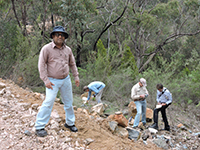News
Indian geoscientists share minerals expertise with Australian colleagues
Published:19 November 2014

Visiting geologists from the Geological Survey
of India undertaking fieldwork in the Wee Jasper
area of New South Wales with Geoscience Australia staff.
Geoscience Australia recently hosted three geoscientists from the Geological Survey of India, creating an opportunity for collaboration on several cutting-edge research projects that are helping to unlock the mineral potential of eastern Australia.
Geoscience Australia's Group Leader of Mineral Systems, Dr Richard Blewett, said that the geological similarities between India and Australia mean that our countries often face similar challenges in the discovery of new mineral provinces concealed under layers of deep sedimentary and volcanic cover rocks.
The visiting scientists were particularly impressed with projects being undertaken under the Australian Government National Mineral Exploration Strategy's UNCOVER vision, aimed at attracting mineral exploration investment with the potential to lead to the discovery of new mineral resources. Two regional geology and drilling projects are currently being led by Geoscience Australia in the Southern Thomson Orogen, which stretches along the border between New South Wales and Queensland; and the Stavely region in Western Victoria.
Senior geologist, Dattatreya S. Jeere explained that project work in India is typically undertaken at deposit scale, and that he has been particularly excited to be able to explore integration of available geological, geophysical and geochemical data at larger scale and within a mineral systems framework.
His colleague, geophysicist Ajay V. Kulkarni appreciated the opportunity to gain hands-on experience in the interpretation of deep crustal reflection seismic transects, and developed further understanding on how this approach can be integrated with other geophysical datasets to develop regional scale interactive 3D models.
"Although deep seismic transects are not routinely acquired in India, these datasets will become increasingly important in the future," Mr Kulkarni said.
The visitors were also able to familiarise themselves with some of Geoscience Australia's data acquisition techniques in the field; and to learn from Australian expertise in the radiometric, or gamma-ray spectrometric method used for mineral exploration and environmental mapping.
They appreciated the opportunity to explore the HyLogging™ analysis technique, which determines the mineral composition of drill core samples through reflectance spectroscopy. This included an opportunity to observe first-hand the HyLogging™ analysis of a drill core from the Stavely area of Victoria at the Geological Survey of South Australia in Adelaide.
Email:




